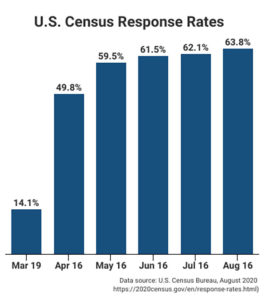With Changes and Action, We Are Capable of Getting a Complete Census Count
Statement by Dr. Bricio Vasquez, IDRA demographer and education data scientist. Dr. Vasquez serves as the Texas Counts education subcommittee co-chair.
(San Antonio * August 19, 2020) – The U.S. Census Bureau’s sudden decision to cut short its population counting window jeopardizes the future of millions of youth. The Census Bureau has always had a problem with undercounting marginalized populations, which impacts distribution of critical education dollars and political representation. The 2020 Census had the added burden of operating in the midst of a pandemic.
By eliminating a whole month of counting as schools reopen, an undercount of crisis levels is practically certain.
 The census has counted only 63.8% of U.S. households. The count rate has stagnated this summer. In mid-May the national rate was 59.5%.
The census has counted only 63.8% of U.S. households. The count rate has stagnated this summer. In mid-May the national rate was 59.5%.
This year, the census is complicated by COVID-19 and the Department of Commerce’s racist questions and timelines.
Prior to COVID-19, the Census Bureau planned to complete counting by July 31, 2020. It then extended the deadline to October 31 due to COVID-19. Now, the Department of Commerce (the federal agency overseeing that houses the Census Bureau) asserts it can achieve a complete count by September 30 and must stop by then to deliver the counts to President Trump by the end of the year as required. The White House contends an extra month will not make a difference.
Trend data, however, show that even more time is needed coupled with expanded strategies, particularly to reach underserved areas.
Census undercounts affect marginalized populations most. These populations include young children; highly-mobile persons; Black, Indigenous, People of Color (BIPOC); non-English speakers; individuals and families with limited economic means; persons experiencing homelessness or who do not live in traditional housing; unauthorized immigrants; LGBTQ persons; and people with mental or physical disabilities.
The places across the United States with most need for funding and resources are the places with the most challenges in getting an accurate and complete census. For example, in Catron County, New Mexico 23.3% of the population lives at or below the poverty line and only 18.4% of households completed the census form. Similarly, Hidalgo County, Texas, has a poverty rate of 30.0% and a census response rate of 49.6%. And McDowell County in West Virginia has a poverty rate of 35.4% and a census response rate of 23.7%
The Stakes Are High
This is about more than just a number. Census data determine $675 billion in funding for public schools and universities as well as hospitals, roads, childcare centers, senior centers and other services for families. Businesses, community leaders and local governments use census data to create jobs, ensure public safety preparedness and support community initiatives.
An undercount of children and families will not only disproportionately impact communities of color, it will also hurt the broader communities in which they live.
IDRA urges the Census Bureau to keep the deadline of October 31, 2020, to get us closer to a complete and accurate count of all people living in the United States. Congress can extend the legal deadline to deliver the results of the census past December 31.
We encourage individuals and local communities to get counted and to remind your family, friends and neighbors to complete their census at my2020census.gov or by calling 844-330-2020. You can shape the future for yourself, your family and your community for the next 10 years and beyond.
We encourage schools to launch a campaign right away to increase count rates in your communities by September 30.
See our list of actions schools can take right away (See PDF version).
Register for IDRA’s webinar on August 27 for more ideas: The Power Schools Bring to the Last Days of the 2020 Census – How Schools Can Help their Communities Get Counted.



